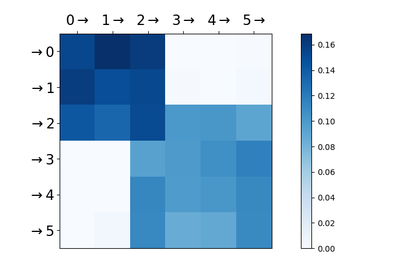tick.hawkes.HawkesADM4¶
-
class
tick.hawkes.HawkesADM4(decay, C=1000.0, lasso_nuclear_ratio=0.5, max_iter=50, tol=1e-05, n_threads=1, verbose=False, print_every=10, record_every=10, rho=0.1, approx=0, em_max_iter=30, em_tol=None)[source]¶ A class that implements parametric inference for Hawkes processes with an exponential parametrisation of the kernels and a mix of Lasso and nuclear regularization
Hawkes processes are point processes defined by the intensity:
\[\forall i \in [1 \dots D], \quad \lambda_i(t) = \mu_i + \sum_{j=1}^D \sum_{t_k^j < t} \phi_{ij}(t - t_k^j)\]where
\(D\) is the number of nodes
\(\mu_i\) are the baseline intensities
\(\phi_{ij}\) are the kernels
\(t_k^j\) are the timestamps of all events of node \(j\)
and with an exponential parametrisation of the kernels
\[\phi_{ij}(t) = \alpha^{ij} \beta \exp (- \beta t) 1_{t > 0}\]In our implementation we denote:
Integer \(D\) by the attribute
n_nodesVector \(\mu \in \mathbb{R}^{D}\) by the attribute
baselineMatrix \(A = (\alpha^{ij})_{ij} \in \mathbb{R}^{D \times D}\) by the attribute
adjacencyNumber \(\beta \in \mathbb{R}\) by the parameter
decay. This parameter is given to the model
- Parameters
decay :
floatThe decay used in the exponential kernel
C :
float, default=1e3Level of penalization
lasso_nuclear_ratio :
float, default=0.5Ratio of Lasso-Nuclear regularization mixing parameter with 0 <= ratio <= 1.
For ratio = 0 this is nuclear regularization
For ratio = 1 this is lasso (L1) regularization
For 0 < ratio < 1, the regularization is a linear combination of Lasso and nuclear.
max_iter :
int, default=50Maximum number of iterations of the solving algorithm
tol :
float, default=1e-5The tolerance of the solving algorithm (iterations stop when the stopping criterion is below it). If not reached it does
max_iteriterationsverbose :
bool, default=FalseIf
True, we verbose thingsn_threads :
int, default=1Number of threads used for parallel computation.
if
int <= 0: the number of physical cores available on the CPUotherwise the desired number of threads
print_every :
int, default=10Print history information when
n_iter(iteration number) is a multiple ofprint_everyrecord_every :
int, default=10Record history information when
n_iter(iteration number) is a multiple ofrecord_every- Attributes
n_nodes :
intNumber of nodes / components in the Hawkes model
baseline :
np.array, shape=(n_nodes,)Inferred baseline of each component’s intensity
adjacency :
np.ndarray, shape=(n_nodes, n_nodes)Inferred adjacency matrix
References
Zhou, K., Zha, H., & Song, L. (2013, May). Learning Social Infectivity in Sparse Low-rank Networks Using Multi-dimensional Hawkes Processes. In AISTATS (Vol. 31, pp. 641-649).
-
__init__(decay, C=1000.0, lasso_nuclear_ratio=0.5, max_iter=50, tol=1e-05, n_threads=1, verbose=False, print_every=10, record_every=10, rho=0.1, approx=0, em_max_iter=30, em_tol=None)[source]¶ Initialize self. See help(type(self)) for accurate signature.
-
fit(events, end_times=None, baseline_start=None, adjacency_start=None)[source]¶ Fit the model according to the given training data.
- Parameters
events :
listoflistofnp.ndarrayList of Hawkes processes realizations. Each realization of the Hawkes process is a list of n_node for each component of the Hawkes. Namely
events[i][j]contains a one-dimensionalnumpy.arrayof the events’ timestamps of component j of realization i.If only one realization is given, it will be wrapped into a list
end_times :
np.ndarrayorfloat, default = NoneList of end time of all hawkes processes that will be given to the model. If None, it will be set to each realization’s latest time. If only one realization is provided, then a float can be given.
baseline_start :
Noneornp.ndarray, shape=(n_nodes)Set initial value of baseline parameter If
Nonestarts with uniform 1 valuesadjacency_start :
Noneornp.ndarray, shape=(n_nodes, n_nodes)Set initial value of adjacency parameter If
Nonestarts with random values uniformly sampled between 0.5 and 0.9`
-
get_history(key=None)¶ Returns history of the solver
- Parameters
key :
str, default=NoneIf
Noneall history is returned as adictIf
str, name of the history element to retrieve
- Returns
output :
listordictIf
keyis None orkeyis not in history then output is a dict containing history of all keysIf
keyis the name of an element in the history, output is alistcontaining the history of this element
-
get_kernel_norms()[source]¶ Computes kernel norms. This makes our learner compliant with
tick.plot.plot_hawkes_kernel_normsAPI- Returns
norms :
np.ndarray, shape=(n_nodes, n_nodes)2d array in which each entry i, j corresponds to the norm of kernel i, j
-
get_kernel_supports()[source]¶ Computes kernel support. This makes our learner compliant with
tick.plot.plot_hawkes_kernelsAPI- Returns
output :
np.ndarray, shape=(n_nodes, n_nodes)2d array in which each entry i, j corresponds to the support of kernel i, j
-
get_kernel_values(i, j, abscissa_array)[source]¶ Computes value of the specified kernel on given time values. This makes our learner compliant with
tick.plot.plot_hawkes_kernelsAPI- Parameters
i :
intFirst index of the kernel
j :
intSecond index of the kernel
abscissa_array :
np.ndarray, shape=(n_points, )1d array containing all the times at which this kernel will computes it value
- Returns
output :
np.ndarray, shape=(n_points, )1d array containing the values of the specified kernels at the given times.
-
objective(coeffs, loss: float = None)[source]¶ Compute the objective minimized by the learner at
coeffs- Parameters
coeffs :
numpy.ndarray, shape=(n_coeffs,)The objective is computed at this point
loss :
float, default=`None`Gives the value of the loss if already known (allows to avoid its computation in some cases)
- Returns
output :
floatValue of the objective at given
coeffs
Notes
Because of the auxiliary variables, the expression of the truly optimized objective is a bit modified. Hence this objective value might not reach its exact minimum especially for high penalization levels.
-
score(events=None, end_times=None, baseline=None, adjacency=None)[source]¶ Compute score metric Score metric is log likelihood (the higher the better)
- Parameters
events :
listoflistofnp.ndarray, default = NoneList of Hawkes processes realizations used to measure score. Each realization of the Hawkes process is a list of n_node for each component of the Hawkes. Namely
events[i][j]contains a one-dimensionalnumpy.arrayof the events’ timestamps of component j of realization i. If only one realization is given, it will be wrapped into a list If None, events given while fitting model will be usedend_times :
np.ndarrayorfloat, default = NoneList of end time of all hawkes processes used to measure score. If None, it will be set to each realization’s latest time. If only one realization is provided, then a float can be given.
baseline :
np.ndarray, shape=(n_nodes, ), default = NoneBaseline vector for which the score is measured If
Nonebaseline obtained during fitting is usedadjacency :
np.ndarray, shape=(n_nodes, n_nodes), default = NoneAdjacency matrix for which the score is measured If
Noneadjacency obtained during fitting is used- Returns
likelihood :
doubleComputed log likelihood value
